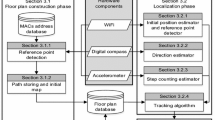Abstract
Floor control refers to the need for coordinating activities occurred in synchronously cooperating applications shared among collaborators. We address this for ubiquitous collaboration—the capability of multiple users to link together with disparate access device anytime and anywhere. Floor control has been studied for years but most researchers focus on relaxed coordination mechanisms with stationary devices that allow updates by any user on any object and resolve the uncoordinated updates. In this paper we present a floor control mechanism, called XGSP-Floor, which implements a coordination mechanism at application level for enabling users to consistently share the same resource in real time (synchronous collaboration) in ubiquitous collaboration environment. The implementation platform on cell phone devices may not be new. But we believe the implementation and experiment for XGSP-Floor on cell phone devices is a new challenge in ubiquitous collaboration environment even though the coordination mechanism can intuitively impose a tremendous overhead in worst case. We also describe the results of the modeling of XGSP-Floor and formal verification to prove the correctness of the modeling using Colored Petri Nets. We describe lessons learned and discuss future work.







Similar content being viewed by others
References
Access Grid (2003) http://www.accessgrid.org
Banavar G, Beck J, Gluzberg E, Munson J, Sussman J, Zukowski D (2000) Challenges: an application model for pervasive computing. Proceedings of the Sixth Annual International Conference on Mobile Computing and Networking, Mobicom, pp 266–274
Berry L, Bartram L, Booth KS (2005) Role-based control of shared application views. Proceedings of the ACM Symposium on User Interface Software and Technology, ACM, pp 23–32
B’Far R (2005) Mobile computing principles: designing and developing mobile applications with UML and XML. Cambridge University Press
Bishop M. Introduction to computer security. Addison Wesley
Community Grids Lab (CGL), http://communitygrids.iu.edu
CPN Tools, CPN Tools Homepage. http://wiki.daimi.au.dk/cpntools/
Dommel HP, Garcia-Luna-Aceves JJ (1995) Design issues for floor control protocols. Proceedings of SPIE Multimedia and Networking, (San Jose, CA, USA), pp 305–16, February
Dommel HP, Garcia-Luna-Aceves JJ (1997) Floor control for multimedia conferencing and collaboration. ACM Multimedia Systems, Vol. 5, No. 1, January 1997
Edwards WK (1997) Flexible conflict detection and management in collaborative applications. In: Proceedings UIST’97: ACM SIGGRAPH Symposium on User Interface Software and Technology. Banff, pp 139–148
Foster I, Kesselman C, Tuecke S (2001) The anatomy of the grid: enabling scalable virtual organizations. Int J High Perform Comput Appl 15(3):200–222
Fox G, Wu W, Uyar A, Bulut H, Pallickara S (2003) Global multimedia collaboration system. In: Proceedings of the 1st International Workshop on Middleware for Grid Computing co-located with Middleware 2003, June 17, 2003 Rio de Janeiro
Gallasch G, Kristensen LM (2001) Comms/CPN: a communication infrastructure for external communication with design/CPN. Proceedings of the CPN’2001 Workshop
Global-MMCS (Global Multimedia Collaboration System). http://www.globalmmcs.org
Greenberg S (1990) Sharing views and interactions with single-user applications. Proceedings of the ACM/IEEE Conference on Office Information Systems. Cambridge, pp 227–237
Greenberg S (1991) Personalizable groupware: accommodating individual roles and group differences. Proceedings of the ECSCW ‘91 European Conference of Computer Supported Cooperative Work. Amsterdam: Kluwer Academic, pp 17–32
Greenberg S, Marwood D (1994) Real time groupware as a distributed system: concurrency control and its effect on the interface. Proceedings of the ACM CSCW Conference on Computer Supported Cooperative Work, October 22–26, 1994. North Carolina, ACM
Handley M, Wakeman I, Crowcroft J (1995) CCCP: conference control channel protocol: a scalable base for building conference control applications. In: ACM Conf. SIGCOMM., August
Java. http://java.sun.com/
Jensen K (1997) Coloured Petri nets: basic concepts, analysis methods and practical use, vol. 1, basic concepts, monographs in theoretical computer sciences. Springer-Verlag
Johanson B, Fox A (2002) The event heap: a coordination infrastructure for interactive workspaces. Proceedings of the 4th IEEE Workshop on Mobile Computing Systems and Applications (WMCSA), pp 83–93
Katrinis K, Parissidis G, Plattner B (2004) Activity sensing floor control in multimedia collaborative applications. 10th International Conference on Distributed Multimedia Systems
Kim K (2007) A framework for synchronous and ubiquitous collaboration. Indiana University PhD November 2007
Malpani R, Rowe LA (1997) Floor control for large-scale MBone seminars. Proceedings of the Fifth ACM International Conference on Multimedia, ACM, pp 155–163
Moore’s Law. http://en.wikipedia.org/wiki/Moore’s_Law
Morris MR, Ryall K, Shen C, Forlines C, Vernier F (2004) Beyond “social protocols”: Multi-user coordination policies for co-located groupware. Proceedings of the ACM Conference on Computer Supported Cooperative Work, ACM, pp 262–265
NaradaBrokering, http://www.naradabrokering.org
OpenH323 Project (2001) http://www.openh323.org
Pallickara S, Gadgil H, Fox G (2005) On the discovery of topics in distributed publish/subscribe systems. Proceedings of the IEEE/ACM GRID 2005 Workshop, pp 25–32. Nov 2005, Seattle
Qiu X (2005) Message-based MVC architecture for distributed and desktop applications. Syracuse University PhD, March 2005
Rosenberg J et al. (2002) SIP: session initiation protocol. RFC 3261, Internet Engineering Task Force, http://www.ietf.org/rfc/rfc3261.txt
Stefik M, Bobrow DG, Foster G, Lanning S, Tatar D (1987) WYSIWIS revised: early experiences with multiuser interfaces. ACM Trans Office Inform Syst 5(2):147–167
Sun C, Ellis C (1998) Operational transformation in real-time group editors: issues, algorithms, and achievements. CSCW ‘98: Proceedings of the 1998 ACM Conference on Computer Supported Cooperative Work, Seattle, Nov 1998, pp 59–68
SVGArena (2003) http://www.svgarena.org/
Treo 600, retail availability since June 2003. http://en.wikipedia.org/wiki/Treo_600
Weiser M (1991) The computer for the twenty-first century. Scientific American, Sep. 1991
Wu W, Fox G, Bulut H, Uyar A, Altay H (2004) Design and implementation of a collaboration web-services system. Special issue on Grid computing in Journal of Neural Parallel and Scientific Computations (NPSC) 12:391–408
Acknowledgments
Many thanks to my former colleagues at Community Grids Lab in Pervasive Technology Labs in Indiana University who developed the earlier prototypes of the system described here.
Author information
Authors and Affiliations
Corresponding author
Rights and permissions
About this article
Cite this article
Kim, K., Fox, G.C. Modeling, simulation, and practice of floor control for synchronous and ubiquitous collaboration. Multimed Tools Appl 53, 213–236 (2011). https://doi.org/10.1007/s11042-010-0508-0
Published:
Issue Date:
DOI: https://doi.org/10.1007/s11042-010-0508-0




